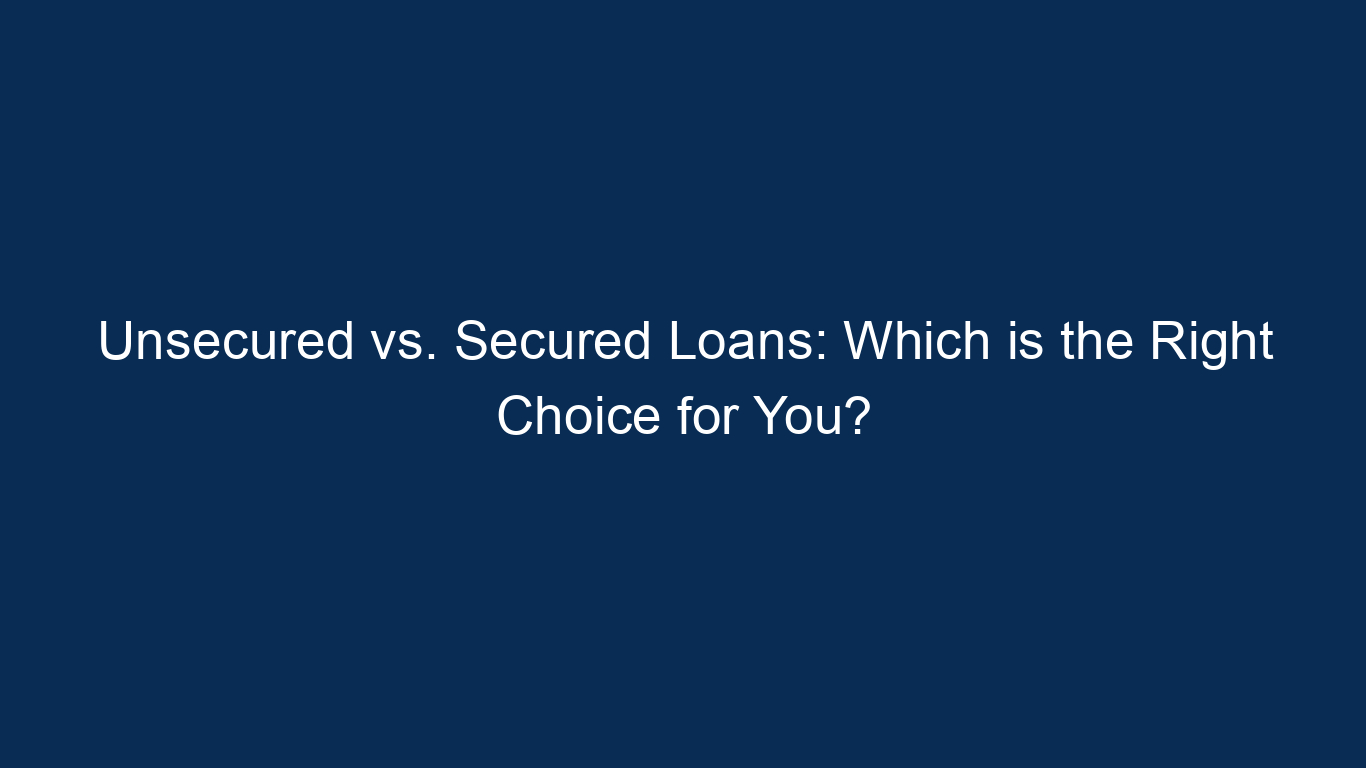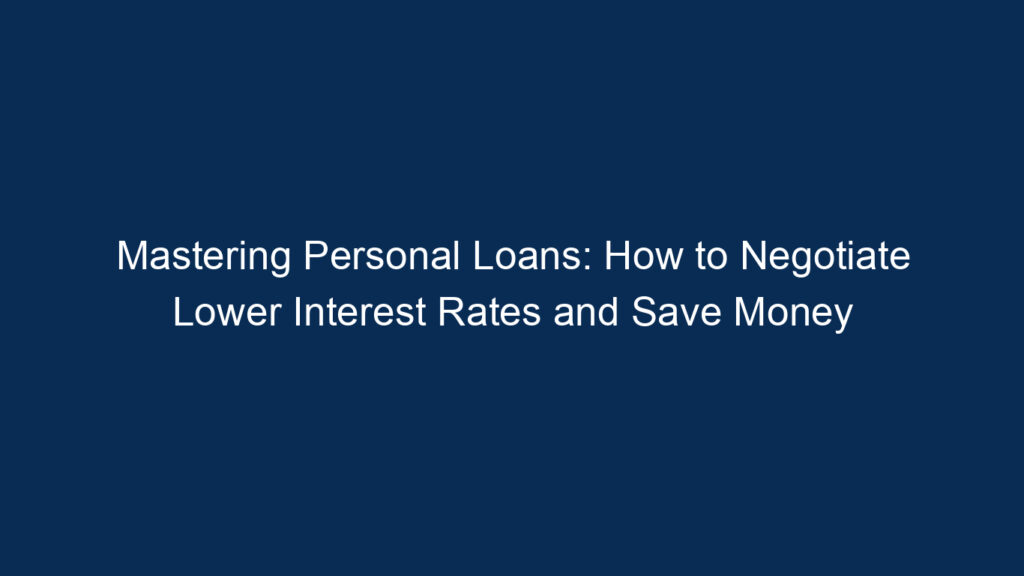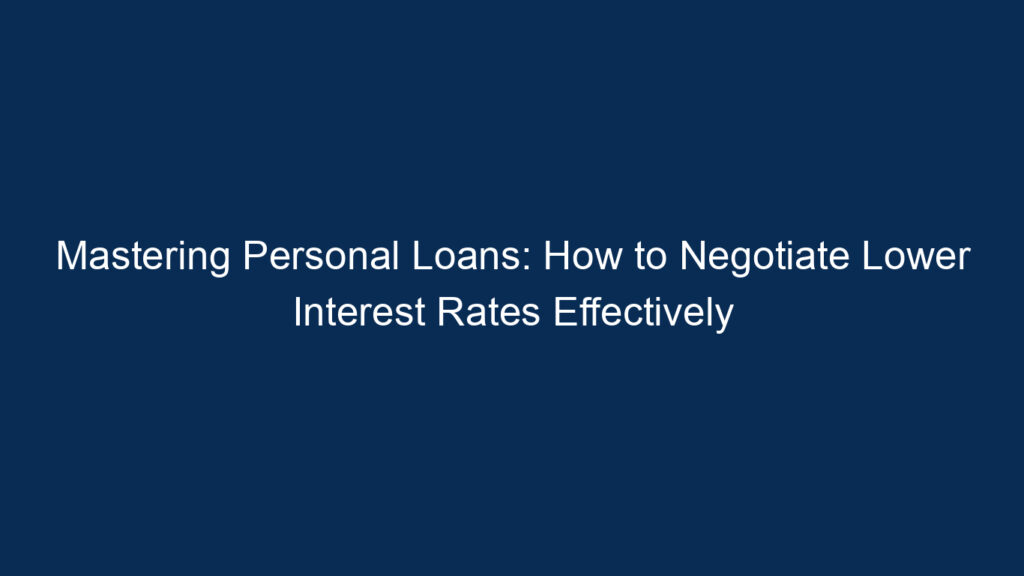When it comes to borrowing money, individuals are often faced with the decision between unsecured and secured loans. Both options offer distinct advantages and considerations, making it essential to understand the differences before making a choice. Unsecured loans are typically granted based on an individual’s creditworthiness, while secured loans require collateral to secure the loan amount. This article will explore the characteristics of both loan types, providing insights into their benefits and helping readers determine which choice is best suited for their financial needs. By delving into the intricacies of unsecured and secured loans, individuals can make an informed decision that aligns with their financial goals and circumstances.
Table of Contents
Understanding the Difference: Unsecured vs. Secured Loans
When seeking a loan, it is important to understand the difference between unsecured and secured loans. Both options have their own advantages and disadvantages, and choosing the right type of loan can greatly impact your financial situation.
Unsecured loans are loans that are not backed by collateral. This means that the lender does not have any claim to your assets if you fail to repay the loan. Examples of unsecured loans include personal loans, credit cards, and student loans. Since these loans are not secured by collateral, lenders typically rely on the borrower’s creditworthiness to determine eligibility and interest rates. Unsecured loans often have higher interest rates compared to secured loans, as the lender is taking on more risk.
On the other hand, secured loans are loans that are backed by collateral. This means that the lender can seize the collateral if the borrower defaults on the loan. Common examples of secured loans include mortgages and auto loans. Because the lender has a form of security, secured loans generally have lower interest rates compared to unsecured loans. The value of the collateral may also affect the amount you can borrow.
The choice between unsecured and secured loans depends on your specific financial situation and needs. If you have a strong credit history and are confident in your ability to repay the loan, an unsecured loan may be a suitable option. These loans offer more flexibility as they do not require collateral. However, if you have a low credit score or need to borrow a larger amount, a secured loan may be more appropriate. The collateral provides security for the lender, allowing you to potentially access lower interest rates and higher loan amounts.
It is important to carefully consider the terms and conditions of any loan before making a decision. Understanding the difference between unsecured and secured loans will help you make an informed choice that aligns with your financial goals. Be sure to compare interest rates, repayment terms, and any additional fees associated with the loan. Additionally, it is always recommended to consult with a financial advisor or loan specialist to ensure you fully understand the implications of the loan and its impact on your financial well-being.
In conclusion, unsecured loans and secured loans differ in terms of collateral requirements, interest rates, and risk levels. Unsecured loans do not require collateral, have higher interest rates, and rely on creditworthiness. Secured loans, on the other hand, require collateral, have lower interest rates, and offer potentially higher loan amounts. Carefully assessing your financial situation and needs will help you determine which type of loan is the best fit for you.
Pros and Cons: Weighing the Benefits of Unsecured and Secured Loans
Pros and Cons: Weighing the Benefits of Unsecured and Secured Loans
When it comes to borrowing money, there are two main options to consider: unsecured loans and secured loans. Each type of loan has its own set of pros and cons, which can greatly impact your borrowing experience. In this article, we will explore the benefits and drawbacks of both unsecured and secured loans, allowing you to make an informed decision based on your individual needs and circumstances.
Unsecured Loans:
An unsecured loan is a type of loan that does not require you to provide collateral as security. This means that you do not have to put up any valuable assets, such as your home or car, as a guarantee for the loan. Here are some of the pros and cons of unsecured loans:
Pros:
- No collateral required: The main advantage of unsecured loans is that you don’t have to risk losing your valuable assets if you default on the loan. This can provide peace of mind for borrowers who are not comfortable putting their assets at risk.
- Quick approval process: Unsecured loans typically have a faster approval process compared to secured loans. This is because there is no need for the lender to assess the value of collateral, making the loan application process quicker and more streamlined.
- Flexibility in spending: Unsecured loans give borrowers the freedom to spend the loan amount on any purpose they choose. Whether it’s for a home renovation, debt consolidation, or a vacation, you have the flexibility to use the funds as you see fit.
Cons:
- Higher interest rates: Since unsecured loans do not require collateral, lenders consider them to be riskier. To compensate for this risk, lenders often charge higher interest rates on unsecured loans compared to secured loans. This can result in higher monthly payments and overall borrowing costs.
- Limited borrowing capacity: Without collateral, lenders may be hesitant to lend large amounts of money through unsecured loans. This means that the borrowing capacity of unsecured loans is often lower than that of secured loans, making it less suitable for big-ticket expenses.
Secured Loans:
A secured loan, on the other hand, is a loan that requires you to provide collateral as security. The collateral can be any valuable asset that you own, such as your home, car, or savings account. Here are the pros and cons of secured loans:
Pros:
- Lower interest rates: One of the main advantages of secured loans is that they often come with lower interest rates compared to unsecured loans. Since the lender has collateral to back up the loan, they are more willing to offer lower interest rates, resulting in potentially lower monthly payments and overall borrowing costs.
- Higher borrowing capacity: Since secured loans are backed by collateral, lenders are more willing to lend larger amounts of money. This makes secured loans a suitable option for major expenses, such as buying a new car or funding a home renovation project.
- Potential for better terms: With collateral, you may have access to better loan terms, such as longer repayment periods or more flexible repayment options. This can make it easier for you to manage your monthly payments and fit them into your budget.
Cons:
- Risk of asset loss: The biggest drawback of secured loans is the risk of losing your collateral if you default on the loan. If you are unable to make your loan payments, the lender has the right to seize and sell your collateral to recover their losses. This can be a significant risk
How to Choose the Right Loan: Factors to Consider
When considering taking out a loan, it is important to carefully evaluate your options and choose the right one for your specific needs. There are several factors to consider before making a decision. This article will outline the key factors to keep in mind when choosing a loan, helping you make an informed and responsible choice.
- Purpose of the Loan: Start by identifying the purpose of the loan. Are you planning to use it for a specific investment, such as buying a house or starting a business? Or do you need it for general purposes, like debt consolidation or covering unexpected expenses? Different loan types are designed to meet different needs, so understanding your purpose will help narrow down your options.
- Interest Rates: Interest rates significantly impact the total cost of a loan. It is crucial to compare interest rates offered by different lenders and loan products. Fixed-rate loans have a consistent interest rate over the loan term, while variable-rate loans may fluctuate with market conditions. Consider your financial situation and preferences to determine which type of interest rate is more suitable for you.
- Loan Term: The loan term refers to the length of time you have to repay the loan. Shorter terms generally mean higher monthly payments but lower overall interest costs, while longer terms offer lower monthly payments but higher interest costs over time. Assess your financial situation and ability to make regular payments to choose a loan term that aligns with your goals and budget.
- Repayment Flexibility: Consider the repayment options available for each loan. Some loans may allow you to make extra payments or pay off the loan early without penalties, while others may have restrictions. Assess your financial flexibility and determine whether you need the freedom to make additional payments or if you prefer a more structured repayment plan.
- Fees and Charges: Loans often come with various fees and charges, such as origination fees, prepayment penalties, or late payment fees. Be sure to understand all the associated costs of a loan and factor them into your decision-making process. Compare these costs across different loan options to choose the one with the most favorable terms.
- Credit History and Score: Your credit history and credit score play a vital role in loan approval and interest rate determination. Lenders assess your creditworthiness to determine the risk of lending to you. Before applying for a loan, check your credit report and score. If your credit score is low, you may need to work on improving it or consider alternative loan options.
- Lender Reputation: Research the reputation and credibility of potential lenders. Read customer reviews, check their track record, and assess their customer service. Choosing a reputable lender can provide peace of mind and ensure a smooth borrowing experience.
- Loan Amount: Consider the amount of money you need and whether the loan options you are considering offer the required amount. Some lenders have minimum or maximum loan limits, so ensure that the loan you choose aligns with your financial needs.
By carefully considering these factors, you can make an informed decision when choosing the right loan for your circumstances. Remember to compare multiple loan options, evaluate their pros and cons, and consult with financial professionals if needed. Loan decisions should be made responsibly, considering your financial situation and long-term goals.
Unsecured vs. Secured Loans: Which Option is Best for Your Financial Needs?
When it comes to borrowing money, there are two main options to consider: unsecured loans and secured loans. Both types serve different financial needs and come with their own set of advantages and disadvantages. In order to make an informed decision, it is important to understand the key differences between the two.
Unsecured loans are not backed by any collateral, such as a house or a car. These loans are typically based on the borrower’s creditworthiness and are granted solely on the promise of repayment. Because of this, unsecured loans often have higher interest rates compared to secured loans.
Secured loans, on the other hand, require some form of collateral to secure the loan. This collateral can be an asset of value, such as a house, a car, or even savings in a bank account. The lender can seize the collateral if the borrower fails to repay the loan. Due to the presence of collateral, secured loans generally have lower interest rates than unsecured loans.
The choice between unsecured and secured loans depends on your specific financial needs and circumstances. Here are some factors to consider:
- Credit history: If you have a strong credit history and a good credit score, you may be eligible for lower interest rates on an unsecured loan. On the other hand, if your credit history is less than perfect, a secured loan may be a safer option as the collateral can provide added security for the lender.
- Loan amount: Unsecured loans are typically offered for smaller amounts, while secured loans can provide access to larger sums of money. This is because lenders are more willing to lend larger amounts when there is collateral involved.
- Repayment period: Unsecured loans generally have shorter repayment periods compared to secured loans. If you need a longer time to repay the loan, a secured loan may be a better choice.
- Risk tolerance: If you are comfortable with the risk of losing your collateral in case of default, a secured loan may be a viable option. However, if you do not want to put any assets at risk, an unsecured loan might be a better fit.
Ultimately, the choice between unsecured and secured loans depends on your individual financial situation. It is important to carefully consider your needs, evaluate the terms and conditions of each loan, and seek professional advice if necessary. By doing so, you can make an informed decision that best meets your financial needs.
In conclusion, choosing between unsecured and secured loans depends on various factors, including your financial situation, credit history, and borrowing needs. Unsecured loans are more accessible and don’t require collateral, making them suitable for individuals with good credit and stable income. On the other hand, secured loans offer lower interest rates and higher borrowing limits, making them ideal for individuals who can provide collateral. It is important to carefully consider your circumstances and evaluate the risks and benefits associated with each option before making a decision. Ultimately, the right choice for you will depend on your specific financial goals and needs. It is advisable to consult with a financial advisor or loan expert to make an informed decision and ensure that your borrowing choice aligns with your long-term financial well-being.






